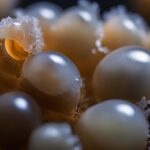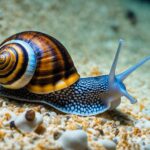Most shrimp tanks require some kind of filtration to guaranteed the water quality stays stable and safe. This is especially important in tanks with limited biological filtration like corner filters or sponge filters.
On the other hand, it can be possible to keep shrimp without a filter. By keeping a heavily planted aquarium with deep layers of soil, nutrient uptake from the plants helps limit how much waste accumulates in tanks – reducing the need for filtration (and regular water changes).
However, this is difficult for beginner aquarists since it requires careful control of light and fertilization levels – so unless you know a lot about planted tank care, it’s usually best to stick with some form of mechanical filtration.

With many years experience, I have constructed this article to help the wider shrimp community gain insight around the requirement for a filter. Lets explore the shrimp filters and clarify the question, do shrimp need a filter.
The function of a filter in a shrimp tank
The role of filters in shrimp tanks is essential to maintaining a healthy and happy aquatic environment. They are responsible for straining out large pieces of debris, such as uneaten food or faecal matter, through mechanical filtration. This uses filter media like sponge or ceramic rings that act like sieves to collect and remove particles from the water before they can enter the tank, resulting in clearer water.
Biological filtration is equally as important, as it helps break down any remaining ammonia, nitrites and other toxins produced by biological processes within the aquatic environment. This process also relies on beneficial bacteria that live on the filter media and convert any harmful substances into less toxic substances such as nitrates.
Not only does this improve the overall health of your shrimps but it also makes maintenance easier by reducing the amount of manual cleaning you need to do yourself! By combining mechanical, biological and chemical filtration all fish tank owners can enjoy keeping their tanks clean and free from pollutants that may harm their inhabitants.
What period of time can shrimp last without a filter
Without a proper filtration system in place, shrimp might be able to live for long. While it is true that these creatures are naturally adept at cleaning the tank, their efforts alone aren’t enough to keep everything tidy.
There are many factors that come in to play. Let me list a few:
- Size of tank, specifically volume of water
- Number of shrimp in tank or shrimp to gallon of water.
- Other aquarium life in the tank such as my favourite, snails.
- Age of tank, condition of water, expose to UV light and other environment factors.
For example, if you have a single shrimp, maintain the water condition and everything else is generally in good shape, its possible you can last a good month. If not longer. You will need to execute water changers however.
I had a failure of a filter some years ago, I didn’t know it was dead, and the shrimp were fine for a least 6 weeks.
Will Shrimp die without a filter?
Shrimp can survive without a filter, but it is more difficult to maintain their health and color. Without the benefit of biofiltration, the ammonia level in the water needs to be monitored closely and changed regularly to keep it low.
This adds time and labor to your maintenance routine. Additionally, without a filter there is less oxygen available in the water which can further stress your shrimp. On the other hand, using a filter makes it easier to keep the same tank for an extended period of time as it keeps toxins out while circulating clean water with increased oxygen.
For many shrewd shrimp hobbyists, filters are not seen as a necessity but an added bonus for keeping cherry shrimp healthy and vibrant in appearance. Not only does it save you from having to change tank water on a regular basis but also provides necessary benefits for maintaining good water quality such as removing particles that would otherwise clog up gills or cause bad odors in your aquarium.
Benefits of a Filter with Shrimp
The use of a filter in a shrimp tank is essential for maintaining a healthy and balanced water environment. A high-quality filter removes suspended particles such as organic waste, nitrogenous compounds, and other toxins from the water while also helping to oxygenate the tank. This promotes a clean living environment for your shrimp and provides protection from disease-causing bacteria that can quickly build up without proper filtration. For example, one direct benefit of using a filter is improved water clarity, leading to happier and healthier shrimp in their environment.
In addition to making sure the water quality remains safe for your shrimp, a filter also helps control algae growth by removing excess nutrient content within the water column. Algae blooms can cause an unpleasant appearance in your aquarium, but with the use of activated carbon filters or protein skimmer filters you can greatly reduce their presence. Furthermore, certain types of chemical filtration media are capable of removing heavy metals and other toxic compounds from the tank’s water which can be dangerous to both shrimps and other marine inhabitants. The combination of biological, chemical, and mechanical filtration can work together harmoniously to enhance the overall health of the tank’s inhabitants.
Reduce Molting
Shrimp are incredibly special creatures that continuously go through a process of molting and shell regeneration. As a result, it is important for aquarists to provide the best water conditions possible while they molt. Molting involves shedding the old shell and then absorbing water to create their new shells. The problem arises when the in-tank water isn’t clean before the next cycle of molting.
Minimise Water Change Rate
Having frequent water changes can be detrimental to the health and survival of shrimps. This is because their fragile biology makes them sensitive to even minor variations in their environment, such as the presence of chemicals that build up when the water isn’t cleaned often enough. In addition, shifting pH levels, temperatures and osmotic pressure due to too-frequent water changes bring significant discomfort to these creatures. Fortunately, a filter (or two) provides an effective solution to this problem by reducing how often water changes need to be done.
A filter system filters out all contaminants such as debris and traces of disturbance from previous occupants or tank cleaners that may have been present in the aquarium before the shrimp were introduced. This helps keep the water clean and reduces the build-up of toxins which may otherwise require regular water changes. Filters also allow for a balanced disruption and reinstatement of different chemical components in the water thus significantly lowering the frequency of water change cycles as well as minimizing any shocks caused by sudden shifts in chemistry temperatures or pH levels that might otherwise be fatal to shrimp living in an unprepared environment.
Types of Filter Systems for Shrimp
Oxygenation Filtration for Shrimp Tanks – Air Pump
Providing sufficient oxygenation for any aquarium is critical for healthy fish, especially for shrimp-only tanks. Adding a filter to the tank will help to ensure that your pet shrimps have enough oxygen to breathe and survive. The outtake from a filter will create a current which will cause turbulence on the surface of the water. This movement aids in gas exchange from the atmosphere, introducing oxygen into the tank as well as releasing built up carbon dioxide.
Air stones are also very effective when it comes to oxygenating aquariums. This is an important feature for shrimp-only aquariums because shrimp species typically require higher levels of dissolved oxygen than other fish species do. The air stones disperse air bubbles which agitate the surface of the water and provide efficient gas exchange with ambient air, ensuring your tank waters remain properly oxygenated and safe for your shrimps.
Mechanical filtration for Shrimp
Mechanical filtration usually involves the use of pads or sponges designed to trap solid particles and organic wastes from the water. This helps to improve water clarity and cleanliness in the aquarium, which is essential for shrimp health. The materials used for mechanical filtration are highly effective at trapping larger particles and are generally easy to install and maintain.
Mechanical filters are relatively inexpensive and simple to use. It can be customized depending on the size of your tank, so you can choose a suitable filter that fits your budget. Regularly cleaning the mechanical filters is important as failing to do so may result in poor water conditions due to wastage buildup inside of the filter media. Over time, the pads and sponges will get clogged which will affect their effectiveness at filtering out particles from the tank. A proper maintenance routine should be established to ensure optimal performance from mechanical filters used in an aquarium setup.
Biological filtration for Shrimp
There are a few ways to incorporate biological filtration into an aquarium. Canister filters, hang-on-back filters, or any filter that has compartments all make it relatively easy to add biological media into your tank. These special filter medias provide high density surface areas where beneficial bacteria colonies can grow and thrive with no need for filter maintenance or cleaning since they can be added directly into the tank. Therefore, by taking the initiative to implement biological filtration media into your shrimp tank, you will be providing both yourself and your fish with a clean and healthy environment.
Additionally, incorporating biological filter media such as Biohome Ultimate and Seachem Matrix can even reduce nitrates along with ammonia and nitrites, furthering the positive impact on tank quality.
Chemical filtration for Shrimp
Most filters come with compartments that can easily be filled with chemical filter media such as carbon or resins. These media remove odors, discoloration and residual medicines that accumulate over time. Additionally, some chemical filter media can modify pH, GH and KH parameters in order to keep the aquarium healthy.
If space is limited or there are concerns about clogging a filter, it’s possible to just add the chemical filter media directly into the tank without a need of additional equipment. This method has the same effectiveness as any other but it requires more frequent maintenance because all of the chemicals need to be replaced at once instead closing and replacing compartments on an existing filter system. However, whichever method you choose, chemical filtration is an absolute must if you want your aquatic environment to remain healthy, stable and clean!
Reasons to not have a filter in your Shrimp Tank
Firstly, choosing to not have a filter in your shrimp tank can be a cost-effective decision. As filters require maintenance and power, it can be an expensive and time-consuming commitment – especially when caring for smaller tanks. Without having a filter, the initial set up and running costs of the tank are much lower, allowing more money to go towards setting up the aquarium and in buying shrimps and decorations.
Another benefit of not having a filter is that there will be less disruption in the water flow for the shrimps, reducing stress on them. The current from most filters can be too strong for these small creatures; resulting in them struggling to move around the aquarium or being displaced from their habitats altogether.
As some types of freshwater shrimp stay in one spot without feeding on driftwood or other areas like many fish do, this kind of movement could also affect their ability to feed properly. With no filter, however, you can expect less water movement which is safer for your shrimps.
Do Ghost shrimp need a filter
The filter helps to clean up the water column and keep levels of excess nitrate and ammonia down, preventing pollution that could lead to possible harm to the ghost shrimp population. Without a filter, these contaminants will build up over time, potentially leading to stresses on the shrimp’s immune system or killing them off entirely due to high toxicity concentrations.
Not only does a filter help keep the environment safe for the shrimp, but it can also help remove any leftover foods or other debris that don’t get cleaned up by natural behaviors exhibited by the ghosts. While it is true that these critters tend to be very adept at scavenging for scraps of food or removing waste from the water column themselves, a good quality filter will help make sure that nothing accumulates faster than nature itself intended. Good filtration will also ensure that no pathogens enter your tank , helping keep disease outbreaks away while ensuring a healthy habitat for your Ghost Shrimp.
Do Cherry shrimp need a filter
Keeping cherry shrimp without a filter is not recommended as it can cause various issues. Without enough filtration, the water quality of the tank could drastically become poor. Filters help keep the water clean in the tank and good biomedia in a filter helps break down ammonia and nitrites, which are detrimental to aquatic life that resides there. Without a filter, the ammonia levels might spike, leading to problems such as various diseases for the cherry shrimp living in the tank and even death in extreme cases.
Not having a filter also means not having oxygenation for your tank water, which again causes unhealthy conditions for the shrimp. A good filtration system consisting of both mechanical and biological filtration will ensure that dirt particles are removed from the tank while also breaking down ammonia and nitrates into solids or gas which will eventually be removed by water changes or other processes in more established tanks with established biofilters. With proper care, patience and by setting up an aquarium with a filter; one can definitely keep cherry shrimps happily and healthily!
You need a filter for Reproduction
Shrimp are remarkable for their growth rate and reproductive abilities. They are capable of reaching adulthood in a much shorter period of time than most other aquarium species, with only about two to three months needed for them to reach maturity. Unfortunately, poor water quality can prevent the growth and reproductive success of these adorable shrimp. Poor water conditions can lead to sickly, underdeveloped shrimp that die off prematurely or produce weak offspring that don’t survive very long.
Fortunately, having a filter on your tank will drastically improve water conditions and ensure optimal growing and reproducting environments for your shrimp. An efficient filter prevents algae build-up as well as organic matter such as excess fish food from contaminating the tank which helps create an environment where the shrimp flourish and reproduce successfully. Furthermore, having good filtration also helps maintain proper water temperatures which is necessary for maintaining healthy populations in the tank. Without a filter or proper filtration methods in place, you’ll be unable to sustain a healthy population of shrimp while also promoting their growth and reproduction cycle.
In Conclusions – Do Shrimp Need a Filter?
For those who want beautiful shrimps, don’t be afraid to employ filters as long as its application does not exceed what is beneficial for these crustaceans.
As I said, your shrimp can likely survive for some time, but don’t risk it, and install or replace your filter system.
I also cover the requirement for heaters and shrimp in this article.







